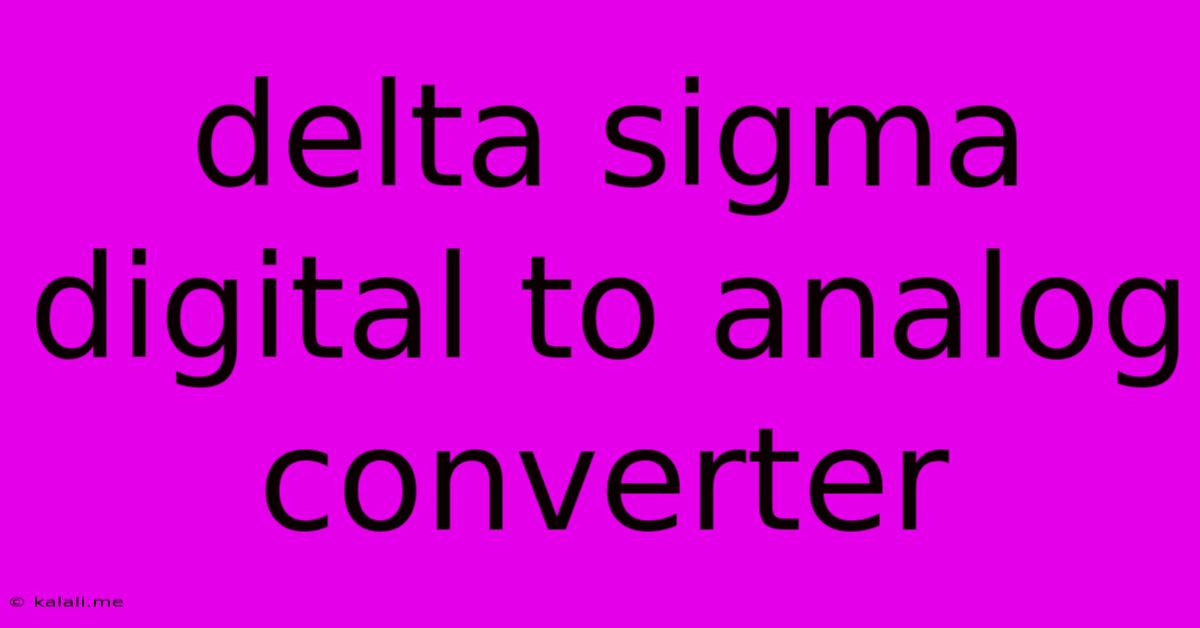Delta Sigma Digital To Analog Converter
Kalali
Jun 04, 2025 · 3 min read

Table of Contents
Decoding the Delta-Sigma Digital-to-Analog Converter (DAC): A Deep Dive
Meta Description: Understand the intricacies of Delta-Sigma Digital-to-Analog Converters (DACs). This article explores their architecture, advantages, disadvantages, and applications, providing a comprehensive guide for electronics enthusiasts and professionals.
Delta-Sigma (ΔΣ) Digital-to-Analog Converters (DACs) are a prominent type of DAC architecture known for their ability to achieve high resolution and accuracy with relatively simple and inexpensive hardware. Unlike conventional DACs, ΔΣ DACs leverage oversampling and noise shaping to achieve their impressive performance. This article will delve into the core principles, advantages, disadvantages, and applications of these sophisticated devices.
Understanding the Fundamentals of ΔΣ DACs
At its heart, a ΔΣ DAC operates based on a feedback loop that continually compares the output analog signal with the digital input. The difference between these two signals (the error) is then quantized and fed back into the system, driving the output signal closer to the desired value. This process is repeated at a significantly higher sampling rate (oversampling) than the input data rate. The high sampling rate allows the quantization noise to be shaped and pushed away from the desired signal bandwidth, resulting in improved resolution and reduced noise.
Key Components of a ΔΣ DAC:
- Quantizer: This component converts the continuous error signal into a discrete digital value, typically 1-bit.
- Integrator: This accumulates the error signal over time, smoothing the output and contributing to noise shaping.
- Feedback Loop: This crucial element ensures the system continuously strives to minimize the difference between the digital input and analog output.
Advantages of ΔΣ DACs:
- High Resolution: They can achieve significantly higher resolution than other DAC architectures with simpler circuitry. This is a major advantage for high-fidelity audio applications and precision instrumentation.
- Reduced Component Count: The use of a 1-bit quantizer simplifies the hardware requirements, reducing cost and complexity.
- High Dynamic Range: Oversampling and noise shaping allow for excellent dynamic range, capturing a wide range of signal amplitudes accurately.
- Easy Calibration: The inherent feedback mechanism often simplifies calibration procedures.
Disadvantages of ΔΣ DACs:
- Higher Power Consumption: The oversampling process can lead to increased power consumption compared to some other DAC architectures. This becomes a significant factor in battery-powered devices.
- Output Filtering Requirements: The output signal needs to be filtered to remove the high-frequency noise components that have been shaped outside the signal bandwidth. This requires additional circuitry.
- Complexity in Design and Implementation: While the core principle is relatively simple, the optimization and design of a ΔΣ DAC to achieve optimal performance can be quite complex.
Applications of ΔΣ DACs:
ΔΣ DACs find wide applications in numerous fields, including:
- High-Resolution Audio: They enable the reproduction of audio signals with exceptional clarity and fidelity.
- Digital Signal Processing (DSP): They play a crucial role in various DSP applications requiring high precision and resolution.
- Medical Instrumentation: Used in precise measurement and control systems.
- Industrial Control: Employing them in feedback loops for accurate process control.
- Telecommunications: Essential for converting digital signals to analog for transmission.
Different Types of ΔΣ DAC Architectures:
Several variations of ΔΣ DAC architectures exist, each with its own strengths and weaknesses, including:
- First-order: Simplest architecture, but limited noise shaping capability.
- Second-order: Offers improved noise shaping performance.
- Higher-order: Provide even greater noise shaping but increase complexity.
Choosing the appropriate architecture depends on the specific application requirements and the desired trade-off between performance, complexity, and power consumption.
Conclusion:
Delta-Sigma DACs represent a significant advancement in digital-to-analog conversion technology. Their ability to deliver high resolution and accuracy with relatively simple hardware makes them a preferred choice across numerous applications. While challenges such as output filtering and power consumption need consideration, the benefits often outweigh these drawbacks, securing their place as a cornerstone of modern electronics. Understanding the underlying principles and various architectures is crucial for anyone working with or designing systems incorporating ΔΣ DACs.
Latest Posts
Latest Posts
-
How To Get Feral Cats To Trust You
Jun 06, 2025
-
Movie About Dark And Light Magic
Jun 06, 2025
-
Stardew Valley Fossil Fishing Ginger Island
Jun 06, 2025
-
What Is The Machine Id Used For Rhel
Jun 06, 2025
-
Do You Gain Hit Dice From Multiclassing
Jun 06, 2025
Related Post
Thank you for visiting our website which covers about Delta Sigma Digital To Analog Converter . We hope the information provided has been useful to you. Feel free to contact us if you have any questions or need further assistance. See you next time and don't miss to bookmark.